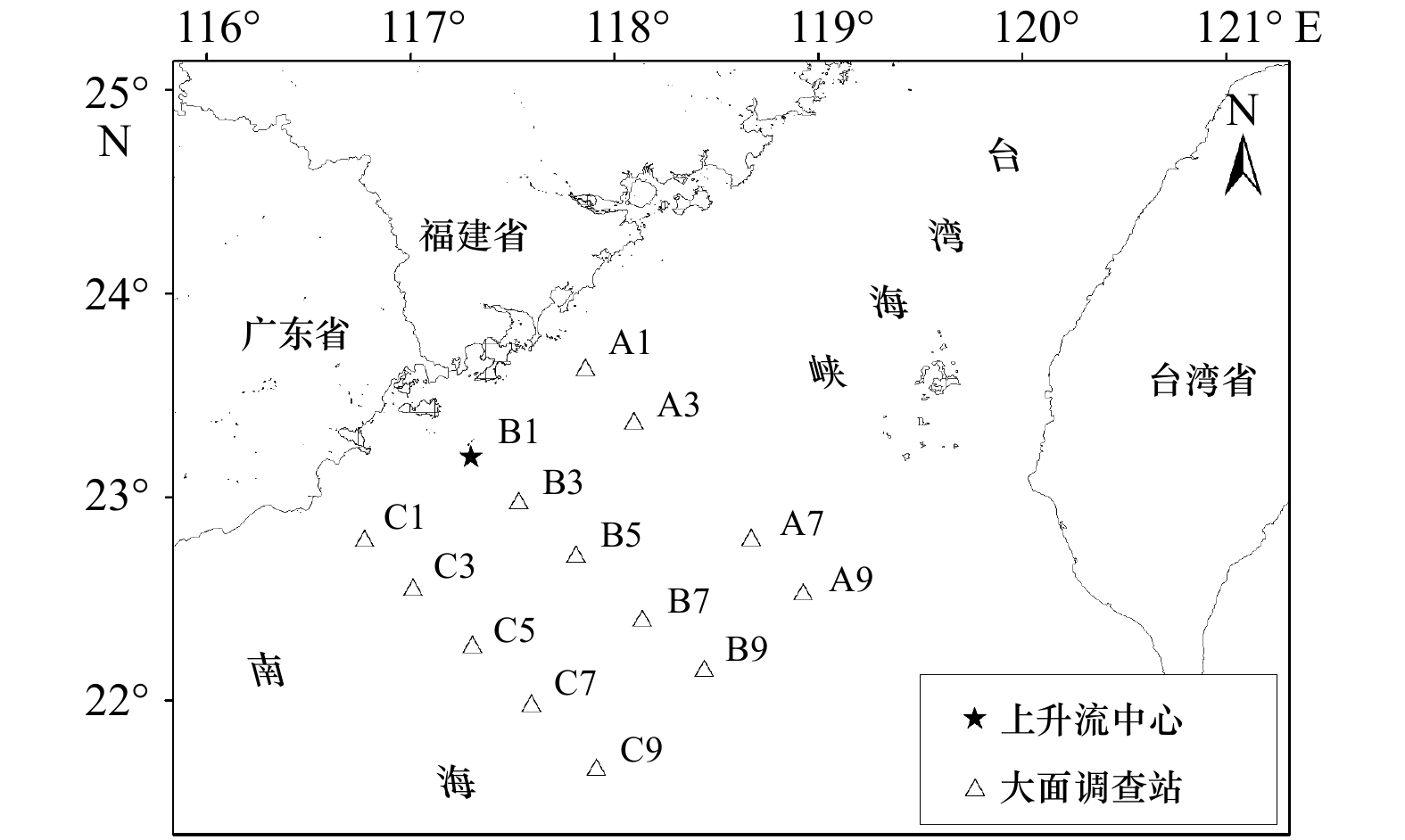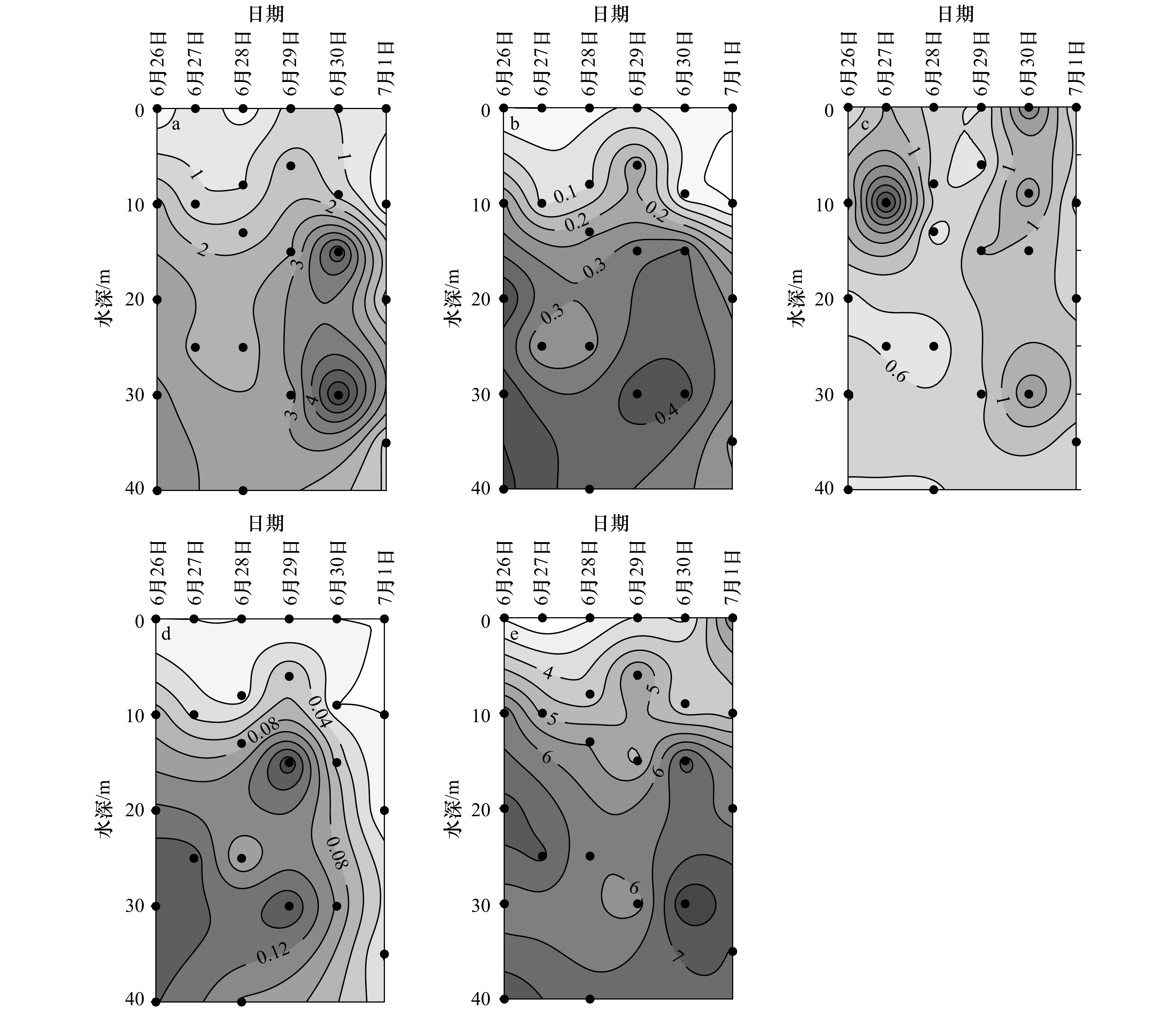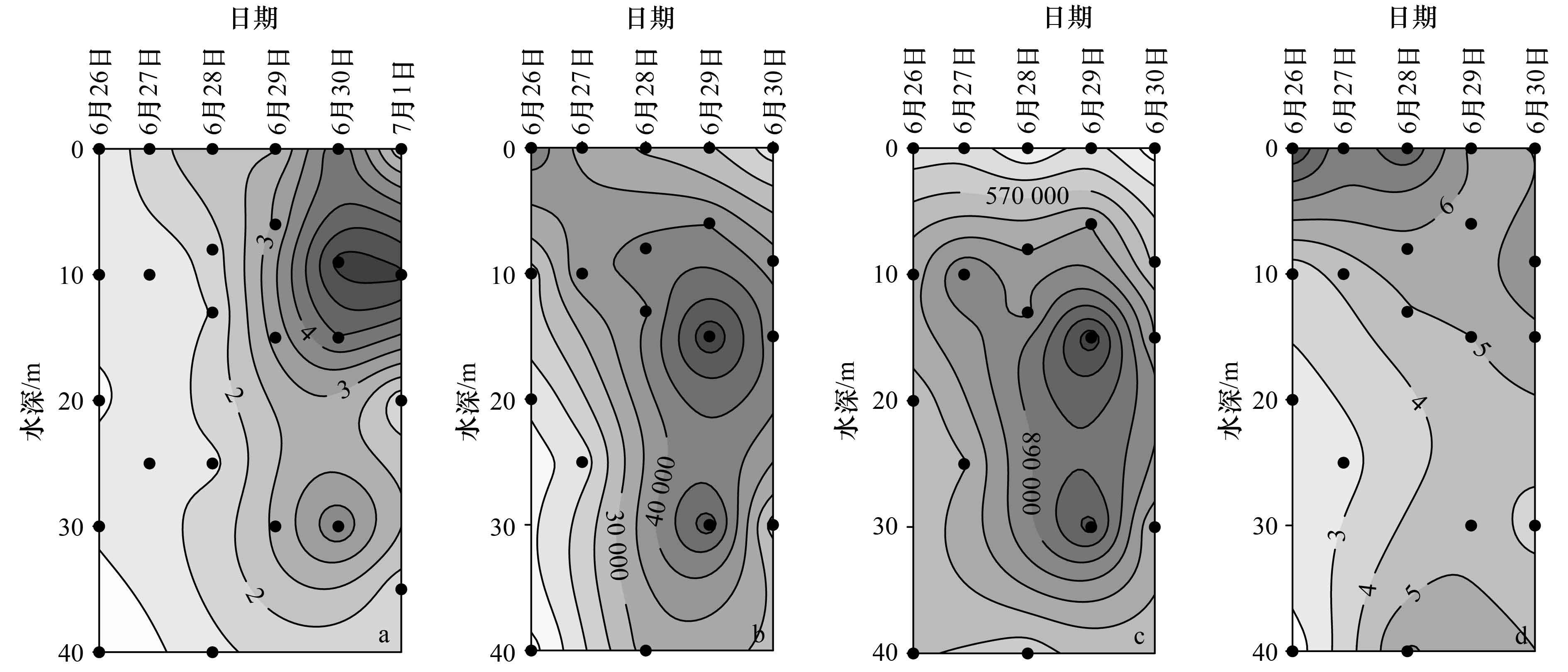Response of aerobic anoxygenic phototrophic bacteria to upwelling in the southern Taiwan Strait of China
-
摘要: 国内外关于好氧不产氧光合异养细菌(AAPB)和上升流之间关系的研究甚少。本文采用“基于蓝细菌校正的时序红外显微技术”研究了台湾海峡南部近岸上升流中心区AAPB对上升流变化的响应。研究结果发现,在上升流涌升的初始阶段,AAPB和总异养细菌丰度较低;随着上升流的发展,两者丰度均增加并在上升流的成熟期达到最高值;而当上升流衰退时,AAPB和总异养细菌丰度开始下降。在上升流发展过程中,AAPB丰度与叶绿素a浓度在一定范围内呈显著正相关,但同时受环境低磷浓度的限制,总异养细菌丰度与氮、磷、硅营养盐均有显著正相关,表明叶绿素a指示的浮游植物所释放的溶解有机碳和环境中的磷限制可能对AAPB起着更为直接和重要的作用,而营养盐则可能在总异养细菌对上升流的响应中起着重要作用。本研究有助于我们理解AAPB在碳及其他生源要素循环中的作用及其调控机制。
-
关键词:
- 好氧不产氧光合异养细菌 /
- 台湾海峡 /
- 上升流
Abstract: There is little information about the relationship between aerobic anoxygenic photoheterotrophic bacteria (AAPB) and upwelling. In this work, the response of AAPB to upwelling in the southern Taiwan Strait was examined, using the “Time-series observation-based cyanobacteria-calibrated InfraRed Epifluorescence Microscopy, TIREM”. The results showed that in the initial stage of upwelling, the abundances of AAPB and total heterotrophic bacteria were low; with the development, their abundances both increased and reached the highest value at the mature stage of upwelling; notably, when the upwelling declined, they began to decrease. During the developmental process of upwelling, AAPB abundance was positively correlated with chlorophyll a concentration in a certain range, and limited by low phosphorus concentration, while total heterotrophic bacteria abundance was positively correlated with nitrogen, phosphorus and silicon nutrients concentration, suggesting that dissolved organic carbon released by phytoplankton and phosphorus limitation might play a more direct and important role in AAPB, while nutrients probably acted as an important role in the response of total heterotrophic bacteria to upwelling. This study will help to better understand the unique role of AAPB in the biogeochemical cycle of carbon and other biogenic elements.-
Key words:
- aerobic anoxygenic phototrophic bacteria /
- Taiwan Strait /
- upwelling
-
图 7 台湾海峡南部海域上升流事件中AAPB丰度(a)、总异养细菌丰度(b)和叶绿素a浓度的相关关系
实心圆代表叶绿素a浓度较低的站位,AAPB丰度与叶绿素a浓度显著正相关;空心圆代表叶绿素a浓度较高的站位,AAPB和总异养细菌丰度与叶绿素a浓度无相关性
Fig. 7 Plots of AAPB abundance (a) and total bacterial abundance (b) vs chlorophyll a concentration in the development of upwelling in the southern Taiwan Strait
The solid circles represent the stations with low chlorophyll a concentration where AAPB abundance is positively correlate with chlorophyll a concentration; the open circles represent the stations with high chlorophyll a concentration where AAPB abundance and total bacterial abundance display little correlation with chlorophyll a concentration
-
[1] Shiba T, Simidu U, Taga N. Distribution of aerobic bacteria which contain bacteriochlorophyll a[J]. Applied and Environmental Microbiolgy, 1979, 38(1): 43−45. doi: 10.1128/AEM.38.1.43-45.1979 [2] Kolber Z S, Plumley F G, Lang A S, et al. Contribution of aerobic photoheterotrophic bacteria to the carbon cycle in the ocean[J]. Science, 2001, 292(5526): 2492−2495. doi: 10.1126/science.1059707 [3] Rathgeber C, Beatty J T, Yurkov V. Aerobic phototrophic bacteria: new evidence for the diversity, ecological importance and applied potential of this previously overlooked group[J]. Photosynthesis Research, 2004, 81(2): 113−128. doi: 10.1023/B:PRES.0000035036.49977.bc [4] Ruiz-González C, Garcia-Chaves M C, Ferrera I, et al. Taxonomic differences shape the responses of freshwater aerobic anoxygenic phototrophic bacterial communities to light and predation[J]. Molecular Ecology, 2020, 29(7): 1267−1283. doi: 10.1111/mec.15404 [5] Sato-Takabe Y, Hirose S, Hori T, et al. Abundance and spatial distribution of aerobic anoxygenic phototrophic bacteria in Tama River, Japan[J]. Water, 2020, 12(1): 150. doi: 10.3390/w12010150 [6] Ferrera I, Sarmento H, Priscu J C, et al. Diversity and distribution of freshwater aerobic anoxygenic phototrophic bacteria across a wide latitudinal gradient[J]. Frontiers in Microbiology, 2017, 8: 175. [7] Selyanin V, Hauruseu D, Koblížek M. The variability of light-harvesting complexes in aerobic anoxygenic phototrophs[J]. Photosynthesis Research, 2016, 128(1): 35−43. doi: 10.1007/s11120-015-0197-7 [8] Sato-Takabe Y, Nakao H, Kataoka T, et al. Abundance of common aerobic anoxygenic phototrophic bacteria in a coastal aquaculture area[J]. Frontiers in Microbiology, 2016, 7: 1996. [9] Koblížek M. Ecology of aerobic anoxygenic phototrophs in aquatic environments[J]. FEMS Microbiology Reviews, 2015, 39(6): 854−870. doi: 10.1093/femsre/fuv032 [10] Jiao Nianzhi, Zhang Yao, Zeng Yonghui, et al. Distinct distribution pattern of abundance and diversity of aerobic anoxygenic phototrophic bacteria in the global ocean[J]. Environmental Microbiology, 2007, 9(12): 3091−3099. doi: 10.1111/j.1462-2920.2007.01419.x [11] Lami R, Cottrell M T, Ras J, et al. High abundances of aerobic anoxygenic photosynthetic bacteria in the South Pacific Ocean[J]. Applied and Environmental Microbiology, 2007, 73(13): 4198−4205. doi: 10.1128/AEM.02652-06 [12] Liu Rulong, Zhang Yao, Jiao Nianzhi. Diel variations in frequency of dividing cells and abundance of aerobic anoxygenic phototrophic bacteria in a coral reef system of the South China Sea[J]. Aquatic Microbial Ecology, 2010, 58(3): 303−310. [13] Hojerová E, Mašín M, Brunet C, et al. Distribution and growth of aerobic anoxygenic phototrophs in the Mediterranean Sea[J]. Environmental Microbiology, 2011, 13(10): 2717−2725. doi: 10.1111/j.1462-2920.2011.02540.x [14] Sato-Takabe Y, Hamasaki K, Suzuki S. High temperature accelerates growth of aerobic anoxygenic phototrophic bacteria in seawater[J]. Microbiologyopen, 2019, 8(5): e00710. doi: 10.1002/mbo3.710 [15] Kolářová E, Medová H, Piwosz K, et al. Seasonal dynamics of aerobic anoxygenic phototrophs in freshwater lake Vlkov[J]. Folia Microbiologica, 2019, 64(5): 705−710. doi: 10.1007/s12223-019-00735-x [16] 洪华生, 丘书院, 阮五崎, 等. 闽南−台湾浅滩渔场上升流区生态系研究[M]. 北京: 科学出版社, 1991.Hong Huasheng, Qiu Shuyuan, Ruan Wuqi, et al. Minnan−Taiwan Bank Fishing Ground Upwelling Ecosystem Study[M]. Beijing: China Science Press, 1991. [17] Wang Dazhi, Hong Huasheng, Huang Bangqin, et al. Phytoplankton biomass (Chl-a) in the Taiwan Strait (1997−1999)[J]. Chinese Journal of Oceanology Limnology, 2002, 20: 33−46. [18] 王玉珏. 台湾海峡上升流区浮游植物对氮营养盐的生理生态响应[D]. 厦门: 厦门大学, 2007.Wang Yujue. Physiological-ecological responses of phytoplankton to nitrogenous nutrients in the Taiwan Strait upwelling area[D]. Xiamen: Xiamen University, 2007. [19] Shang Shaoling, Zhang Caiyun, Hong Huasheng, et al. Hydrographic and biological changes in the Taiwan Strait during the 1997−1998 El Niño winter[J]. Geophysical Research Letters, 2005, 32(11): L11601. doi: 10.1029/2005GL022578 [20] 张彩云. 台湾海峡叶绿素a对海洋环境多尺度时间变动的响应研究[D]. 厦门: 厦门大学, 2006.Zhang Caiyun. Response of chlorophyll a concentrations to multi-scale environmental variations in the Taiwan Strait[D]. Xiamen: Xiamen University, 2006. [21] Bak R P M, Nieuwland G. Seasonal variation in bacterial and flagellate communities of deep-sea sediments in a monsoonal upwelling system[J]. Deep-Sea Research Part II: Topical Studies in Oceanography, 1997, 44(6/7): 1281−1292. [22] Caffrey J M, Hollibaugh J T, Bano N, et al. Effects of upwelling on short-term variability in microbial and biogeochemical processes in estuarine sediments from Elkhorn Slough, California, USA[J]. Aquatic Microbial Ecology, 2010, 58(3): 261−271. [23] Cuevasa L A, Daneri G, Jacob B, et al. Microbial abundance and activity in the seasonal upwelling area off Concepción (~36°S), central Chile: a comparison of upwelling and non-upwelling conditions[J]. Deep-Sea Research Part II: Topical Studies in Oceanography, 2004, 51(20/21): 2427−2440. [24] Huang Bangqin, Hong Huasheng, Wang Haili. Size-fractionated primary productivity and the phytoplankton-bacteria relationship in the Taiwan Strait[J]. Marine Ecology Progress Series, 1999, 183: 29−38. doi: 10.3354/meps183029 [25] Huang Bangqin, Lin Xueju, Hong Huasheng. Spatial and temporal variations of Synechococcus and picoeukaryotes in the Taiwan Strait, China[J]. Chinese Journal of Oceanology Limnology, 2009, 27(1): 22−30. doi: 10.1007/s00343-009-0022-2 [26] Kerkhof L J, Voytek M A, Sherrell R M, et al. Variability in bacterial community structure during upwelling in the coastal ocean[J]. Hydrobiologia, 1999, 401: 139−148. doi: 10.1023/A:1003734310515 [27] Kuznar J, Espinoza J C, Avaria S, et al. Microbiological effects produced by a coastal upwelling off central Chile[J]. Revista ole Biologia Marinay Oceanografia, 2009, 44(1): 189−196. [28] Montero P, Daneri G, Cuevas L A, et al. Productivity cycles in the coastal upwelling area off concepcion: the importance of diatoms and bacterioplankton in the organic carbon flux[J]. Progress in Oceanography, 2007, 75(3): 518−530. doi: 10.1016/j.pocean.2007.08.013 [29] Zdanowski M K, Figueiras F G. CFU bacterial fraction in the estuarine upwelling ecosystem of Ria de Vigo, Spain: variability in abundance and their ecophysiological description[J]. Marine Ecology Progress Series, 1999, 182: 1−15. doi: 10.3354/meps182001 [30] Zheng Tianling, Hong Huasheng, Wang Fei, et al. The distribution characteristics of bacterial β-glucosidase activity in Taiwan strait[J]. Marine Pollution Bulletin, 2002, 45(1−12): 168−176. [31] Cuadrat R R C, Ferrera I, Grossart H P, et al. Picoplankton bloom in global south? A high fraction of aerobic anoxygenic phototrophic bacteria in metagenomes from a coastal bay (Arraial do Cabo-Brazil)[J]. Omicsia Journal of Intergrative Biology, 2016, 20(2): 76−87. doi: 10.1089/omi.2015.0142 [32] Jiao Nianzhi, Zhang Yao, Chen Yao. Time series observation based InfraRed Epifluorescence Microscopic (TIREM) approach for accurate enumeration of bacteriochlorophyll-containing microbes in marine environments[J]. Journal of Micro Biological Methods, 2006, 65(3): 442−452. doi: 10.1016/j.mimet.2005.09.002 [33] Zhang Yao, Jiao Nianzhi. Method for quantification of aerobic anoxygenic phototrophic bacteria[J]. Chinese Science Bulletin, 2004, 49(6): 597−599. doi: 10.1360/03wc0447 [34] Schwalbach M S, Fuhrman J A. Wide-ranging abundances of aerobic anoxygenic phototrophic bacteria in the world ocean revealed by epifluorescence microscopy and quantitative PCR[J]. Limnology and Oceanography, 2005, 50(2): 620−628. doi: 10.4319/lo.2005.50.2.0620 [35] Zhang Yao, Jiao Nianzhi. Dynamics of aerobic anoxygenic phototrophic bacteria in the East China Sea[J]. FEMS Microbiology Ecology, 2007, 61(3): 459−469. doi: 10.1111/j.1574-6941.2007.00355.x [36] Zhang Yao, Jiao Nianzhi, Hong Ning. Comparative study of picoplankton biomass and community structure in different provinces from subarctic to subtropical oceans[J]. Deep-Sea Research Part II: Topical Studies in Oceanography, 2008, 55(14/15): 1605−1614. [37] Jiang Hongchen, Dong Hailiang, Yu Bingsong, et al. Abundance and diversity of aerobic anoxygenic phototrophic bacteria in saline lakes on the Tibetan plateau[J]. FEMS Microbiology Ecology, 2009, 67(2): 268−278. doi: 10.1111/j.1574-6941.2008.00616.x [38] Chen Yao, Zhang Yao, Jiao Nianzhi. Responses of aerobic anoxygenic phototrophic bacteria to algal blooms in the East China Sea[J]. Hydrobiologia, 2011, 661(1): 435−443. doi: 10.1007/s10750-010-0553-8 [39] Mentes A, Szabó A, Somogyi B, et al. Differences in planktonic microbial communities associated with three types of macrophyte stands in a shallow lake[J]. FEMS Microbiology Ecology, 2018, 94(2): fix164. [40] Korponai K, Szabó A, Somogyi B, et al. Dual bloom of green algae and purple bacteria in an extremely shallow soda pan[J]. Extremophiles, 2019, 23(4): 467−477. doi: 10.1007/s00792-019-01098-4 [41] Szabó-Tugyi N, Vörös L, Balogh K V, et al. Aerobic anoxygenic phototrophs are highly abundant in hypertrophic and polyhumic waters[J]. FEMS Microbiology Ecology, 2019, 95(8): fiz104. doi: 10.1093/femsec/fiz104 [42] Zhang Fei, Liu Jihua, Li Qiang, et al. The research of typical microbial functional group reveals a new oceanic carbon sequestration mechanism-A case of innovative method promoting scientific discovery[J]. Science China Earth Science, 2016, 59(3): 456−463. doi: 10.1007/s11430-015-5202-7 [43] 胡俊. 台湾海峡南部浮游植物类群组成及其对上升流的响应研究[D]. 厦门: 厦门大学, 2009.Hu Jun. Studies on phytoplankton community structure and its responses to upwelling in southern Taiwan Strait[D]. Xiamen: Xiamen University, 2009. [44] Hu Jun, Lan Wenlu, Huang Bangqin, et al. Low nutrient and high chlorophyll a coastal upwelling system—A case study in the southern Taiwan Strait[J]. Estuarine Coastal Shelf Science, 2015, 166: 170−177. doi: 10.1016/j.ecss.2015.05.020 [45] Parsons T R, Maita Y, Lalli C M. A Manual of Chemical and Biological Methods for Seawater[M]. New York, USA: Pergamon Press, 1984. [46] Pai Sucheng, Yang C C, Riley J P. Formation kinetics of the pink azo dye in the determination of nitrite in natural waters[J]. Analytiac Chimica Acta, 1990, 232: 345−349. doi: 10.1016/S0003-2670(00)81252-0 [47] Pai Sucheng, Yang C C, Riley J P. Effects of acidity and molybdate concentration on the kinetics of the formation of the phosphoantimonylmolybdenum blue complex[J]. Analytica Chimica Acta, 1990, 229: 115−120. doi: 10.1016/S0003-2670(00)85116-8 [48] Habeebrehman H, Prabhakaran M P, Jacob J, et al. Variability in biological responses influenced by upwelling events in the Eastern Arabian Sea[J]. Journal of Marine Systems, 2008, 74(1/2): 545−560. [49] 林丽贞. 台湾海峡南部上升流区浮游植物的磷胁迫与限制[D]. 厦门: 厦门大学, 2007.Lin Lizhen. Phosphorus stress of phytoplankton in upwelling area in southern Taiwan Strait[D]. Xiamen: Xiamen University, 2007. [50] Sieracki M E, Gilg I C, Thier E C, et al. Distribution of planktonic aerobic anoxygenic photoheterotrophic bacteria in the northwest Atlantic[J]. Limnology and Oceanography, 2006, 51(1): 38−46. doi: 10.4319/lo.2006.51.1.0038 [51] Lamy D, Jeanthon C, Cottrell M T, et al. Ecology of aerobic anoxygenic phototrophic bacteria along an oligotrophic gradient in the Mediterranean Sea[J]. Biogeosciences, 2011, 8(4): 973−985. doi: 10.5194/bg-8-973-2011 [52] Shioi Y, Doi M, Arata H, et al. A denitrifying activity in an aerobic photosynthetic bacterium, Erythrobacter sp. Strain OCh 114[J]. Plant and Cell Physiology, 1988, 29(5): 861−865. [53] Ferrera I, Sánchez O, Kolářová E, et al. Light enhances the growth rates of natural populations of aerobic anoxygenic phototrophic bacteria[J]. The ISME Journal, 2017, 11(10): 2391−2393. doi: 10.1038/ismej.2017.79 [54] Fauteux L, Cottrell M T, Kirchman D L, et al. Patterns in abundance, cell size and pigment content of aerobic anoxygenic phototrophic bacteria along environmental gradients in northern lakes[J]. Plos One, 2015, 10(4): e0124035. doi: 10.1371/journal.pone.0124035 [55] Mašín M, Čuperová Z, Hojerová E, et al. Distribution of aerobic anoxygenic phototrophic bacteria in glacial lakes of northern Europe[J]. Aquatic Microbial Ecology, 2012, 66(1): 77−86. doi: 10.3354/ame01558 [56] 刘材材, 项凌云, 张昊飞, 等. 长江口异养细菌生态分布特征及其与环境因子的关系[J]. 海洋环境科学, 2009, 28(S1): 1−4.Liu Caicai, Xiang Lingyun, Zhang Haofei, et al. Distribution and relationship between heterotrophic bacteria and environmental factors in Changjiang Estuary[J]. Marine Environmental Science, 2009, 28(S1): 1−4. -





 下载:
下载:






